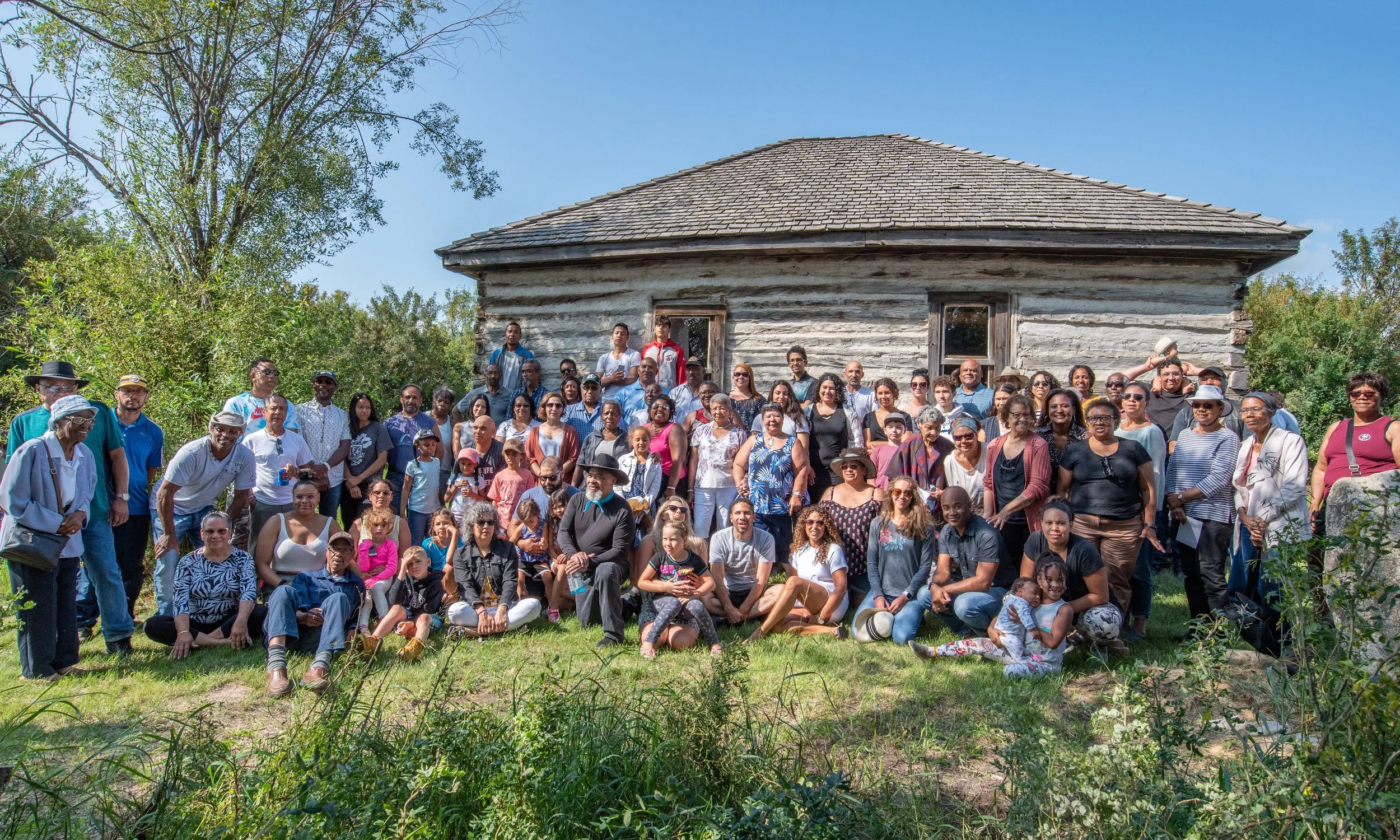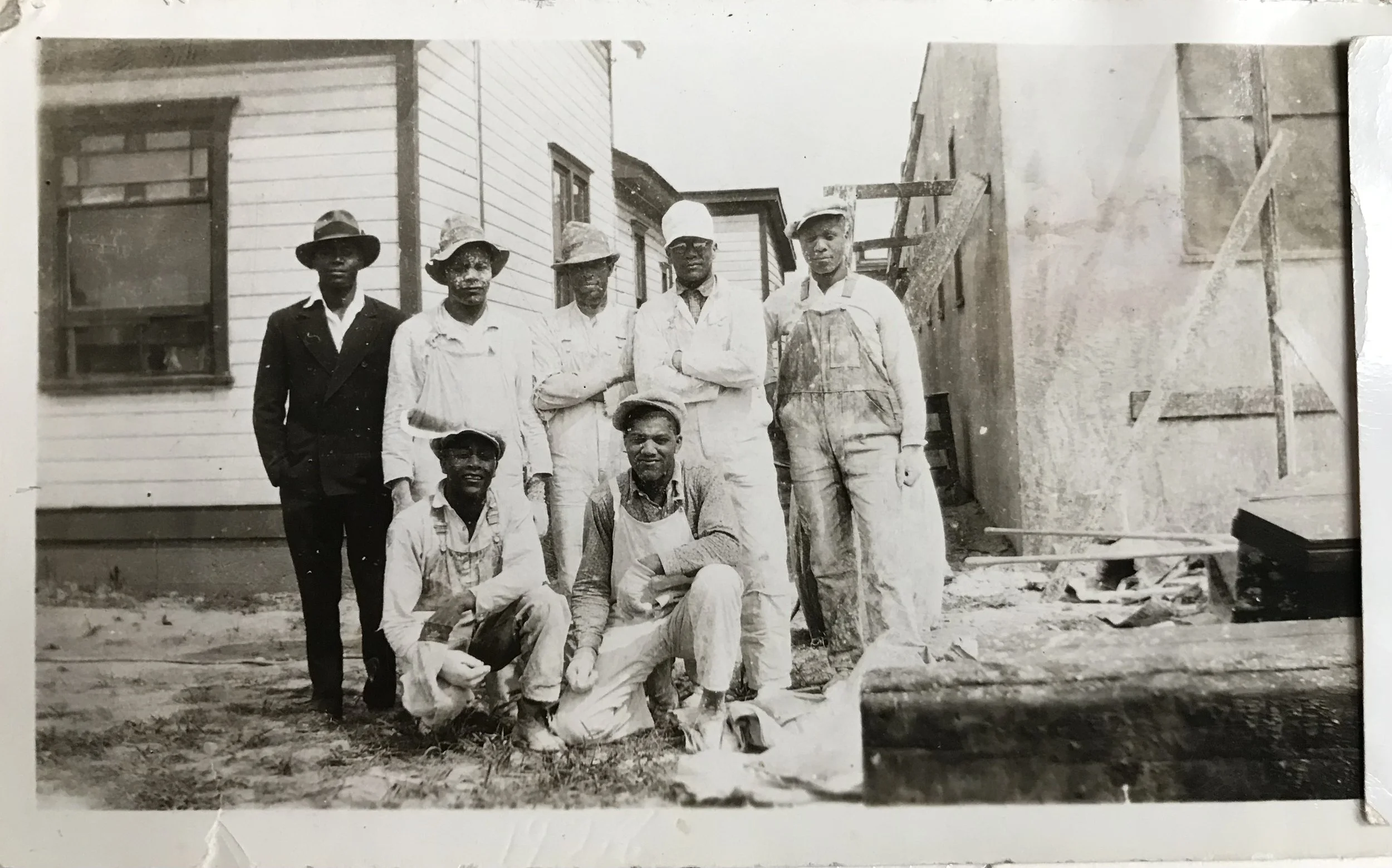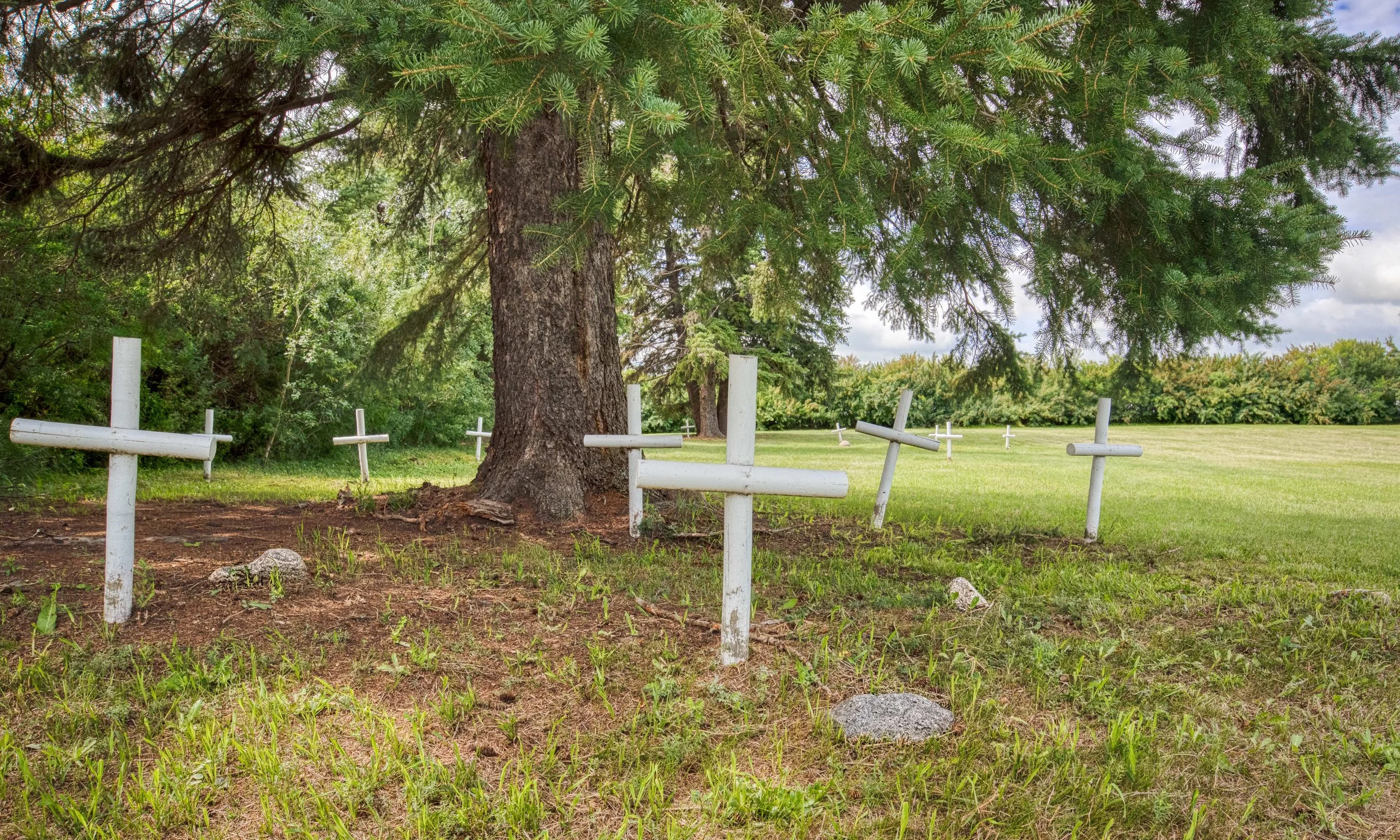VIEWPOINTS
Refusal to be Disappeared
— Cheryl Foggo
Missing architecture requires a deeper means of uncovering a Black presence on the prairie.
Reunion at Shiloh Church. Image © Averil Hall, August 2019.
In 1915, my grandfather’s younger brother Tommy Smith died in an unfinished dirt-floor home in northern Saskatchewan. Someone in the community of Black American Expatriates that included both sets of my maternal great grandparents built a container for his remains. The family loaded the coffin on a wagon and took it to the cemetery. Both the cemetery and the adjacent tiny log Shiloh Baptist Church were recent constructions. The church was situated on the homestead of Wyatt Mayes in 1911, and was the first collectively erected building–the first piece of our communal architecture. The cemetery was created out of necessity in 1913 upon the death of one of the community’s founders, Julius Caesar Lane. The nearby White cemeteries did not want the bodies of Black people. According to the excellent and painstaking research of Leander Lane (great grandson of Julius Caesar Lane), people in the Black enclave took turns acting as undertakers.
Named after their church, the people who created this community and their descendants have since become known as the Shiloh People.
Tommy Smith was one of the first of the Shiloh children to die, but I have no information about the circumstances of his burial. He died in winter and Lane’s research has revealed that if the snow was too deep and the ground frozen, burials had to be postponed.
How desolate it must have been to leave his little body alone in a wooden box, perhaps waiting for a better day to be lowered into the ground.
I am searching for a word or a phrase to describe how strongly I sense the presence of my ancestors when I visit the church and cemetery now. I feel them, I hear them, I bear witness to their lives and their grief and the way I’m certain their community would have gathered around them on that day. The phrase I need would convey that I miss them, even those I never met. I admire and envy their fortitude. I’m grateful.
Among the wild roses growing next to the crosses, the fragrance of that communion is sweetly poignant. Their presence in and on the land feels mythical and long ago. I am conscious in those outdoor spaces, as I should be, that other people who were there for thousands of years prior to our arrival are also there, in layer after layer below. I think about the bitterness of the winters, how much knowledge had to be shared by Indigenous people in order for us to learn how to live here. I believe those early encounters between Black and Indigenous people, each with our own disrupted histories, are responsible for our relationships now. These are the thoughts I sometimes have in natural, green and flowered places, on the land.
Our presence survives in the land itself even when our buildings and the spaces created by us are erased and buried, but there is a different texture to my communion with my ancestors when I place my feet on boards they cut and nailed together. The sound of my own footsteps in Shiloh church echoes theirs, and it’s as though I just missed them by moments. They are near. The walls contain their songs, and the rough, uncomfortable benches still hold the memory of squirming children being shushed by grandmothers. I sang those same songs much later, in different buildings. I squirmed and was shushed by their descendants, the original Shiloh children.
My personal connection to the Shiloh People travels down through my maternal great grandparents, Drucilla and Rufus Smith and Katie and Willie Glover. When they fled violence in the southern US to come to Canada as part of the Black migration of 1910, they homesteaded near Maidstone, Saskatchewan.
Prior to America, my ancestors were Africans, but from where? Probably west Africa, but where? Ghana, Benin? I may never know. They were stolen from their homelands to be enslaved in Arkansas, Alabama, and Texas. After emancipation they migrated to the Indian and Western Territories, where they started thriving businesses and established communities. However, after Oklahoma was created from those territories in 1907, people of African descent on that land experienced increasing murder and terror; we lost the right to vote and our skillfully, lovingly built towns and businesses were bombed and torched.
It's not surprising so many sought safety elsewhere. The Maidstone community was one of five founded by this group of approximately 1,500 African-Americans, and the only one in Saskatchewan. The others were in northern Alberta: Amber Valley, Campsie, Junkins (now Wildwood), and Keystone (now Breton).
Although distinct in many ways, these communities were in close contact with one another throughout the decades after they were established. Despite the miles between them, people travelled back and forth by wagon and horseback and eventually in automobiles. The communities developed and maintained unique characteristics, while also participating in the legacy construction that is the sum of their parts: the baseball games, the social events, the building of houses, barns, churches and schools. They used these gatherings to seek out life partners. Because of the interconnectedness of the hamlets, it can be difficult to parse out which community a family is “from.” Although my direct ancestry is the Shiloh people of Maidstone, I had close relatives who lived in Amber Valley and Campsie, and relatives of relatives who lived in Wildwood and Breton. I consider myself a descendant of those communities as well.
It seems clear from burial practices in the Shiloh Cemetery that many rites of caring for the dead were replicas or adaptations of rites from the African-American south. In an article published in the Spring 2020 issue of Prairies North Magazine about the process of saving the church and cemetery from ruin and obscurity, Leander Lane describes some of these practices:
The community used African-American burial practices in the cemetery beside this church. The deceased were buried in an east to west orientation, with the heads toward the west. This was done so that the dead would not have to turn around when Gabriel blows his trumpet in the eastern sunrise at the end of time. A large fieldstone was laid at the head and foot of each grave. In addition, spruce trees were taken from the banks of the river and planted around the cemetery, a local adaptation of the African-American practice of planting prickly trees around a cemetery in order to ensure the spirits stay inside. [1]
These fragments of knowledge are valuable slivers. How much of this type of knowledge has been lost because our buildings have not survived?
The preservation of physical structures can tell us many things about our collective past, which illuminates the who, why and where of today, and tells us where we should go next.
Roy Williams and some of his brothers and nephews apprenticed in the construction trade in Alberta starting in the late 1920s. When their newly acquired skills in stuccoing, plastering and bricklaying had failed to present employment opportunities, the men resorted to one of the few professions available to Black men and worked as railroad porters instead. What structures might have been erected if given the opportunity? Image © Williams Family, Saskatoon, Saskatchewan, 1928.
When contemplating Black prairie life through the lens of architecture, the invitation to reframe the picture and widen the aperture is welcome. What we built certainly includes our physical structures. It must also consider the structures we would have erected if given the opportunity. I often think of the Williams family of the Maidstone area and a story Judy Williams Graham told me about her father, Roy Williams, and some of his brothers and nephews. In the late 20s and early 30s, the Williams men decided to take up the construction trade, for which they studied and apprenticed. Despite the skills they acquired in stuccoing, plastering and bricklaying, they couldn’t find employment and ended up working as railroad porters, one of the very few options available to Black men. Their focus shifted from building buildings to building community. Both Roy Williams and his brother Lee were instrumental in battles pursuing better working conditions for Black men on the railroads. (As a side note, Roy Williams eventually put his drywalling skills to use when he built his house in Calgary. Although I attended joyful dinner gatherings in the Williams home as a child, I have no memory of the layout and no way of knowing if Roy Williams incorporated African or African-American elements into the house. Judy lived in this house and thinks not.)
Reframing the conversation about Black architectures also requires a broadening of the meaning of the word itself. Our architecture includes multiple instances of Black life and spaces that can no longer be found in a specific building, but are still felt in the lives of our people here. My life today is built on institutions like the Brotherhood of Sleeping Car Porters, the Cultural Association for Black People, the Alberta Association for the Advancement of Coloured People, the Alberta chapters of the Universal Negro Improvement Association, the Coloured People’s Protective Association, etc. Apart from those mutual support societies, our architectures included intangibles.
Some of the institutions they built survive only on paper. We can still discern what they cared about, the unbreakableness of them, when we read of their day-to-day activities in a column called “Our Negro Citizens” that ran regularly in the Edmonton Journal in the early years of the 20th century.
The bonds created by these non-visible architectures are mortared by our music, our stories, and our cuisine, which is beautiful.
But our material architectures hang by a thread. The few remaining pieces of physical evidence that testify to our long Black presence on the prairies teeter and groan. The wind blows through, the sun beats down.
The intervention of someone like Leander Lane is necessary to prevent the loss of a building or a cemetery. Without the work he has done, the little piece of our architecture that survives at Maidstone would surely be gone by now. He has found support of course, but the project of having the site recognized as a Saskatchewan Provincial Heritage Property has cost thousands upon thousands of hours of his life.
I can’t help but feel that these threads from which our architectures hang would be strengthened if our history and contributions held greater value in society at large.
As a child being educated in this country, I knew of the Black migration of 1910 because it was my life. But just as most Canadians didn’t know about that deep presence on the prairies, I didn’t know that this same pattern of erasure went back much further than 1910, because no one told me. It is difficult to learn what you have never been taught.
The more exploring I did as an adult researcher, the more I realized that those of us who came in 1910 had not built community, structures and institutions out of thin air. My ancestors walked into already existing Black life and spaces, made by people like fur traders Joseph Lewis, Glasgow Crawford and the Bonga family; translators Henry and David Mills; entrepreneur Annie Saunders; blacksmith Charles Dyson and his wife Eliza; ranchwoman Flora Wolfe; cowboys Billy Welsh, Green Walters and of course John Ware; Ware’s in-laws the Lewis family; railroad worker and civil rights icon Charles Daniels; and many, many others, who lived and built in these landscapes before us, in some cases going back to the late 1700s.
To my knowledge, the only physical structures that survive to attest to that pre-1910 Black presence are John Ware’s second cabin at Dinosaur Provincial Park in Alberta, and the barn Ware helped to build on the Bar U Ranch.
Lacking photographs and other visual records creates barriers to dissemination, including in publishing, in filmmaking and in the creation of resources for academia and education in general. Physical and particular types of written record are the only kinds of evidence that count for many of the keepers of history in museums, history departments in universities, archives and media outlets.
Yet many of those physical records are absent by design and have been baked into record-keeping systems for hundreds of years. Enslaved Africans were not named in census data; they were listed only as numbers of humans “owned” by slaveholders. Huge data gaps in the written records of Black people in the United States and Canada were also created by the enslavement of Africans on the continent through the withholding of literacy. Attempting to acquire literacy as an enslaved person was in many places punishable by death.
For multiple reasons, I have had to unlearn teachings about what is acceptable in research and story-sharing. I have had to insist that oral history must be considered valid.
One major challenge I encounter in my work is the inaccuracy of primary sources, which are considered sacred in most academic and archival spaces.
An example of this happened when I went looking in the 1911 census of Canada for a person I knew to be a Black man living in Calgary in that year. When I found him, I was surprised to see he was listed as Norwegian in the transcript of the census. Several people living in the same apartment building were also listed as Norwegian. After cross-referencing with other sources, I confirmed that he was definitely the Black man I was looking for, and that all the other “Norwegians” living in the building were also Black.
I can’t be certain of what happened between the recording of the information in 1911 and the creation of the typed transcript. I surmise that the census taker had accurately recorded this population as “Negro.” Perhaps the transcriptionist was unable or unwilling to believe there were that many Black people living in one apartment building in Calgary in 1911 and decided the word they were seeing was an abbreviation of Norwegian. Perhaps the original census taker’s handwriting was poor. I don’t know.
My takeaways were numerous. Documents that are considered reliable by some historians are not infallible. Statistics that tell us how many Black people were or are living in Canada at a given time are probably undercounting. These takeaways are not based on that one instance of inaccuracy alone, but on numerous similar ones.
I have also had to unlearn the tendency to interpret Blackness in Canada as a binary with Whiteness, as most traditional historic written records have done.
Throughout our timeline here, we had mutually beneficial and mostly positive relationships with other racialized communities, including Sikh, Chinese, and especially Indigenous people. The late Judi Singh, a well-known Alberta musician of the 70s was the daughter of Effie Jones (of one of the founding Amber Valley families) Singh and Sohan Singh Bhullar. Both of Ms. Singh’s lineages were established in the province in the early 1900s. Mount Royal University Professor Michael Hawley has been documenting and writing about Alberta Black/Sikh relations for years. I have written about the relationship between Black porters in Calgary and a Chinese restaurateur named Hop Wo in the 1910s and 1920s. And stories like that of fluent Cree speaker Peter Risby, the first Black person to be inducted into the Canadian Mining Hall of Fame (2022), echo the stories of Black/Indigenous family and economic ties like that of translator David Mills from the late 1800s. Mills was the son of a Black fur trader father and Blood mother. His wife was Holy Rabbit Woman and he lived among the Kainai for his entire life. These relationships are just a few examples of many. They go back a long way and continue into the present.
These illustrations of the need to challenge and interrupt dominant narratives demonstrate why there are many cautions I bring to my excavations of history. Who is telling the story and why? What might their biases have been? Where did they get their information? Did they cite and credit their sources? Who profited from the publication?
Those of us telling the stories of racialized communities in this country are challenging long-standing narratives that were often created by revered figures. That’s a big boulder to push up a high hill.
From what I know at the time of this writing, none of my family’s own buildings have survived in northern Saskatchewan. But when I walk through spaces like Shiloh Cemetery and Church, I see them clearly.
I celebrate their refusal to be disappeared.
Shiloh Cemetery. Image © Averil Hall, August 2019.
References
[1] Lane, Leander. "Shiloh: Remembering Saskatchewan's African-American Pioneers", Prairies North Magazine, Spring 2020.
To learn more about Black fur traders see: Bickersteth, Bertrand. “Black Fur Traders in Canada”, The Canadian Encyclopedia, March 4, 2020. https://www.thecanadianencyclopedia.ca/en/article/black-fur-traders-in-canada.
To learn more about the life of Annie Saunders, see: Foggo, Cheryl. “Assembling Auntie”, AlbertaViews Magazine, January 2009. https://albertaviews.ca/assembling-auntie/
Cheryl Foggo is an award-winning author, playwright, and filmmaker whose work over the last 30 years has focused on the lives of Western Canadians of African descent. Her books include the recently released 30th-anniversary edition of Pourin’ Down Rain: A Black Woman Claims Her Place in the Canadian West. Her plays Heaven and John Ware Reimagined have been seen on multiple stages across Canada. Her film John Ware Reclaimed can be found at nfb.ca. and her film Kicking Up a Fuss: The Charles Daniels Story can be found on youtube. She is currently working on a documentary about the Shiloh Baptist Church and Cemetery in Saskatchewan.
Guest Editor: Sikomh Kokomii (Calling Crane)






